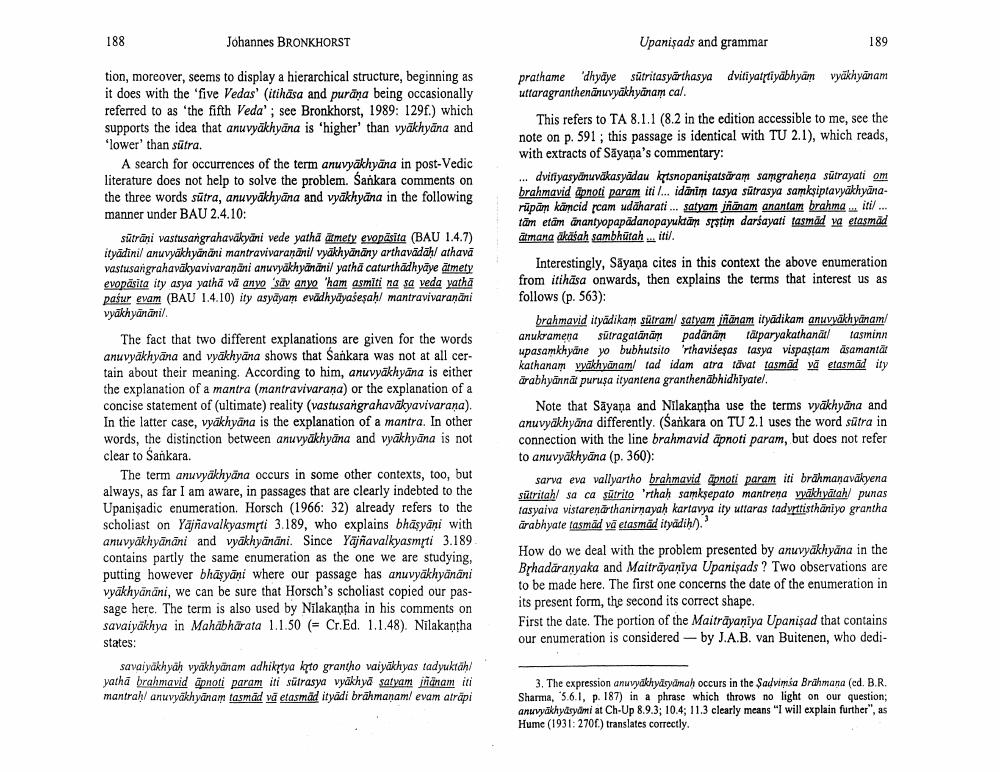Book Title: Upanisads And Grammar On Meaning Of Anuvyakhyana Author(s): Johannes Bronkhorst Publisher: Johannes Bronkhorst View full book textPage 2
________________ 188 Johannes BRONKHORST tion, moreover, seems to display a hierarchical structure, beginning as it does with the 'five Vedas' (itihasa and purana being occasionally referred to as 'the fifth Veda'; see Bronkhorst, 1989: 129f.) which supports the idea that anuvyakhyana is 'higher' than vyakhyāna and 'lower' than sutra. A search for occurrences of the term anuvyakhyāna in post-Vedic literature does not help to solve the problem. Sankara comments on the three words sutra, anuvyākhyāna and vyakhyāna in the following manner under BAU 2.4.10: sūtrani vastusangrahaväkyäni vede yatha atmety evopasita (BAU 1.4.7) ityădinil anuvyäkhyänäni mantravivarananil vyakhyänäny arthavadaḥl athava vastusangrahavakyavivaraṇāni anuvyākhyānānil yatha caturthādhyāye atmety evopasita ity asya yatha va anyo 'sav anyo ham asmiti na sa veda yatha pasur evam (BAU 1.4.10) ity asyayam evadhyayaseṣaḥl mantravivaranani vyākhyānānil. The fact that two different explanations are given for the words anuvyākhyāna and vyakhyāna shows that Sankara was not at all certain about their meaning. According to him, anuvyakhyana is either the explanation of a mantra (mantravivarana) or the explanation of a concise statement of (ultimate) reality (vastusangrahavakyavivarana). In the latter case, vyakhyana is the explanation of a mantra. In other words, the distinction between anuvyākhyāna and vyākhyāna is not clear to Sankara. The term anuvyäkhyāna occurs in some other contexts, too, but always, as far I am aware, in passages that are clearly indebted to the Upanisadic enumeration. Horsch (1966: 32) already refers to the scholiast on Yajnavalkyasmrti 3.189, who explains bhasyani with anuvyäkhyānāni and vyäkhyänäni. Since Yajnavalkyasmrti 3.189. contains partly the same enumeration as the one we are studying, putting however bhāṣyani where our passage has anuvyākhyānāni vyākhyānāni, we can be sure that Horsch's scholiast copied our passage here. The term is also used by Nilakantha in his comments on savaiyakhya in Mahabharata 1.1.50 (= Cr.Ed. 1.1.48). Nilakantha states: savaiyakhyah vyakhyanam adhikṛtya kto grantho vaiyakhyas tadyuktaḥ yatha brahmavid apnoti param iti sütrasya vyakhyā satyam jñānam iti mantraḥl anuvyakhyānam tasmad vā etasmad ityādi brahmanam! evam atrapi Upanisads and grammar prathame 'dhyāye sütritasyarthasya dvitiyatṛtiyabhyam vyäkhyānam uttaragranthenanuvyakhyānam cal. 189 This refers to TA 8.1.1 (8.2 in the edition accessible to me, see the note on p. 591; this passage is identical with TU 2.1), which reads, with extracts of Sāyaṇa's commentary: dvitiyasyanuvākasyadau ktsnopanisatsaram samgrahena sūtrayati om brahmavid apnoti param iti I... idanim tasya sütrasya samkşiptavyäkhyanarūpām kamcid rcam udaharati... satyam jñānam anantam brahma itil... tam etam anantyopapädanopayuktam srstim darśayati tasmäd va etasmād atmana ākāśaḥ sambhutah... itil. Interestingly, Sayana cites in this context the above enumeration from itihasa onwards, then explains the terms that interest us as follows (p. 563): brahmavid ityädikam sütram/ satyam jñānam ityādikam anuvyäkhyanam anukramena sūtragatānām padanam tätparyakathanat! tasminn upasamkhyane yo bubhutsito 'rthavisesas tasya vispaṣṭam asamantat kathanam vyäkhyānam tad idam atra tavat tasmad vā etasmād ity arabhyannāt puruşa ityantena granthenābhidhiyatel. Note that Sayana and Nilakantha use the terms vyakhyāna and anuvyäkhyana differently. (Sankara on TU 2.1 uses the word sutra in connection with the line brahmavid äpnoti param, but does not refer to anuvyakhyāna (p. 360): sarva eva vallyartho brahmavid äpnoti param iti brähmaṇaväkyena sütritahl sa ca sutrito 'rthaḥ samkşepato mantrena vyakhyātah punas tasyaiva vistareṇarthanirnayah kartavya ity uttaras tadyrttisthāniyo grantha arabhyate tasmad va etasmād ityādiḥl)." How do we deal with the problem presented by anuvyakhyāna in the Bṛhadaranyaka and Maitrayaniya Upanisads? Two observations are to be made here. The first one concerns the date of the enumeration in its present form, the second its correct shape. First the date. The portion of the Maitrayaniya Upanisad that contains our enumeration is considered by J.A.B. van Buitenen, who dedi 3. The expression anuvyakhyasyamah occurs in the Şadvimsa Brahmana (ed. B.R. Sharma, 5.6.1, p. 187) in a phrase which throws no light on our question; anuvyakhyasyami at Ch-Up 8.9.3; 10.4; 11.3 clearly means "I will explain further", as Hume (1931: 270f.) translates correctly.Page Navigation
1 2 3 4 5 6 7
